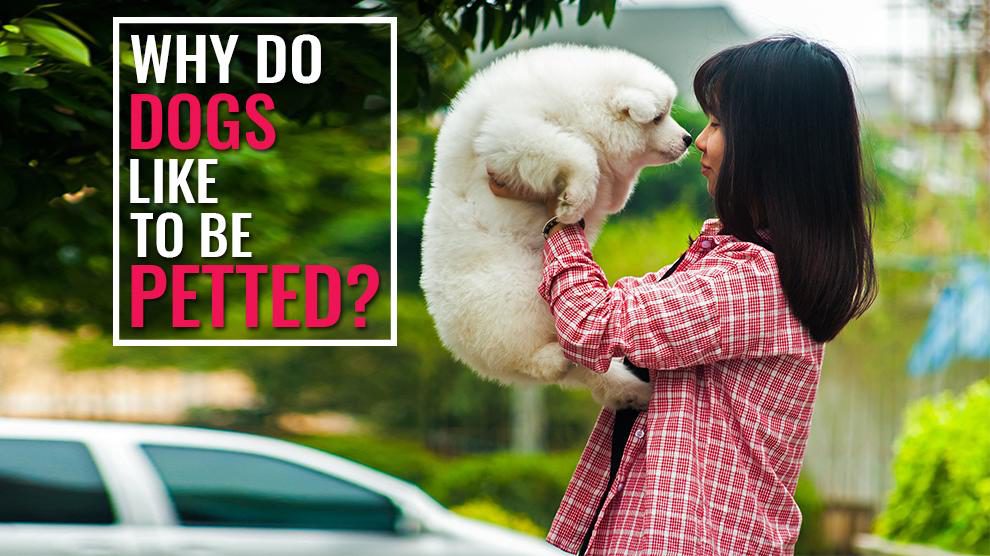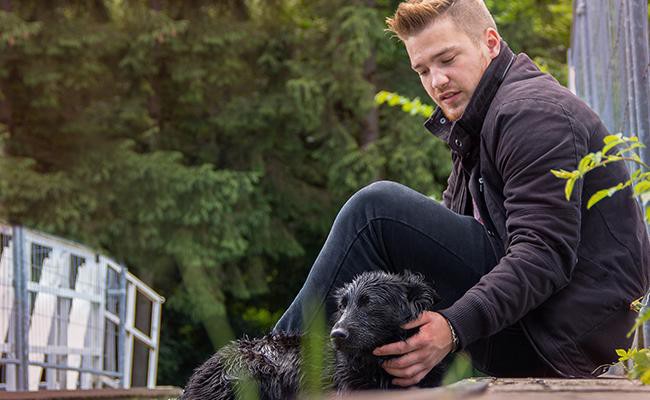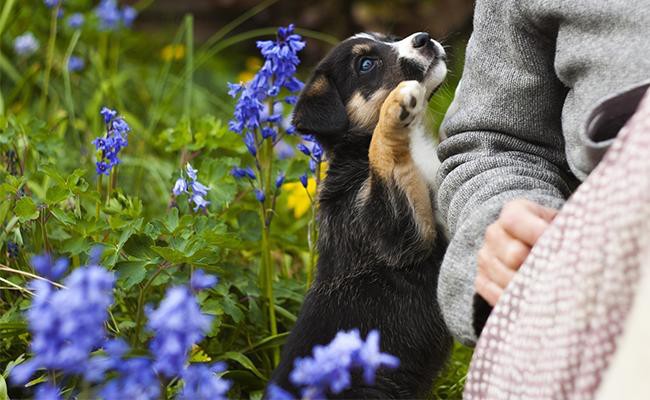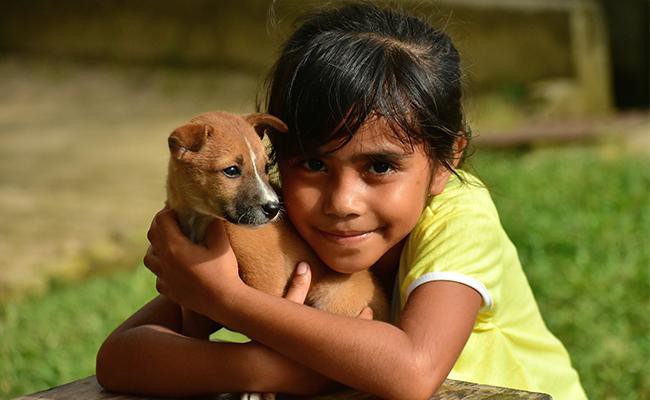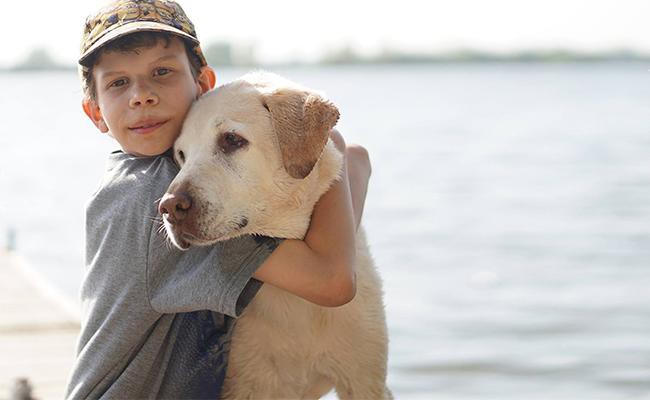Dog Pregnancy Calculator And Timeline
Why do we, actually, like pats and hugs in the first place?
If you own a warm ball of fluffy fur to call your favorite, you know how they wish to be petted. Do dogs like to cuddle? How to show a dog you love them?
Let’s dig deep and learn the truth.
Making Furry Friends By Touching
For dogs, especially friendly ones, touch strengthen bonds. Our ape ancestors groom each other. Research has proved that they take part in this behavior more regularly than necessary.
Grooming might also produce a practical result. Dogs get happy and need it mainly for fun.
Humans engage in gestures such as a small tap on the shoulder, handshakes, or hugs. Patting, stroking, cuddling, and hugging hold good for dogs. These are small gestures.
The display of petting later evolved to enhance the activity with positive sensations. These activities promoted trust, bonding, hygiene, and health.
Researchers are not too sure why it happens, but the final result is highly effective at enhancing good moods, social interaction, and bonding.
Activation of neurons releases oxytocin and endorphins into the brain. These chemical compounds help with bonding, relaxation, and pain relief.
Do Dogs Want To Be Petted All The Time?
Canines love belly rubs. Felines give us a cute expression when you scratch the region between their ears. Humans receive pleasure while hugging.
If you get hit on your arm, a quick swift rub will decrease the pain.
While not all cuddles are enjoyable, all dogs are ready to agree that slighter stroking makes them feel good. They lick you back in response.
This type of touch enhances a group of neurons called MRGPRB4+. The researchers worked with genetically engineered mice. Pet-like stroking at right temperatures activated the neurons producing a pleasant sensation.
These neurons are widely-spaced and it responds to stroking motions. They do not react to poking or pinching.
Why Do Dogs Like To Be Hugged?
Are you aware that April 10th was actually “National Hug Your Dog Day?”
You have probably missed the fact that dogs don’t like hugs. Squeezing and hugging are the main displays of affection that people like us crave for.
In fact, dogs are not “hugging creatures.” Dogs use body pressure and body contact when two canines are sorting their hierarchical relationship or role-playing.
Canines instead love to show their love by simply spending time with people they love.
We all love giving hugs, don’t we? In general, experts state that around 68% of pet parents actually spend more time hugging their dogs than loving the people they live with.
Do Dogs really Like Hugs?
No, dogs do not usually show love and affection to one another as we humans do through hugs.
Humans are known for their natural hugging style. We love ventral-ventral contact or chest to chest hug.
Experts believe humans have this liking because we position ourselves chest to chest when we nursed out mothers as babies. Canines don’t nurse like the way we do, so they don’t use hugs to display their love.
Bear in mind, dogs don’t like face-to-face hugs.
Symptoms of Dog Hug Side-Effects
Did you notice these signs when you gave your canine hugs?
- Avoiding eye contact
- Turning their head
- Shaking off
- Lip licking
- Moving away from you
- Repetitive yawning
These are some of the symptoms of dog hug side-effects. Experts say some dogs may even nip or push their paws. “Whale eye” is visible when a dog is stressed or nervous.
How Dogs Interpret Hugs?
A dog hug means something different for your pets. Dogs may interpret hugs as restraint or confinement. It could even trigger a flight or fight response.
How Do You Hug Your Dog?
Experts claim some dogs lean against them, sit on their laps, dig deep into their humans, or lie under their legs. The less irritating you are with your dog, he will seek out physical contact.
Give them the freedom to move away and they will respond with their love.
Is it possible to train dogs to love hugs?
You can use praises, rewards, and treats to make your dog take hugs from strangers softly.
If your canine does not like to be touched, you should start a very low level. You should start with ‘successive approximations.’
Try 2 minutes sessions followed by a 10-minute break in between.
Steps to help a dog cope with hugs
- Make a stranger stand next to your dog. Give your dog treats and do this for 10 repetitions.
- If your dog performs the first step to your satisfaction, move to the next step.
- Have a stranger move their hand towards your dog while giving treats. Allow the person to stand close by, feeding dog treats.
- Start by touching the flanks and move gradually.
In the canine kingdom, the cues are not that much hard to observe and learn.
How To Show A Dog You Love Them?
To profess that I love my canine would be nothing short of an understatement.
Most dog owners are aware that giving hugs are not a big thing for a dog. Some dog lovers feel that the best way to touch a dog’s heart is by feeding it whatever it likes.
Limit the treats and hugs and there are plenty of ways you can try to show your pet you simply adore him.
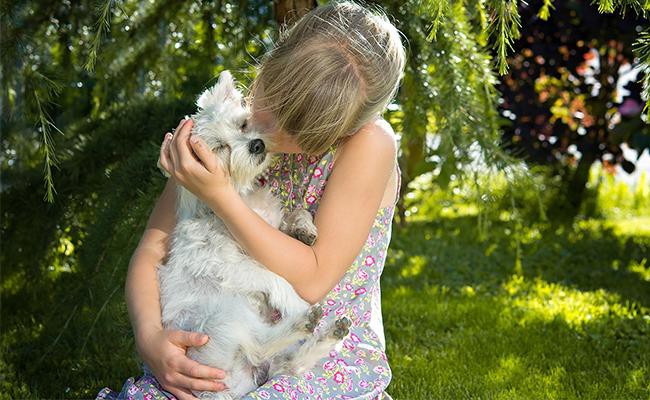
Simple Ways to Tell Your Dog How Much You Love Him
-
Snuggle your dog
Dogs hate hugs as much as they love cuddles. Canines are pack animals. Talk to your vet and you can co-sleep with your dog.
You can lie in the couch with your dog or snuggle him.
Dogs can recognize whether you are really stressed or not.
-
Fun all the way
Spend quality time with your dog. Try teaching your dog something new. Take him for a new game of fetch or frisbee.
Not only you are expressing your love for your dog, but they are also getting exercise.
-
Lean on Him
Have seen your dog ever pressing his legs? This is one of the possible ways your dog is expressing his love for you.
You can either hug him back or snuggle him.
-
Gently Rub His Ears
Try giving your pet dog a gentle rub on his ears. He will react with a lot of happiness. Rubbing a canine’s ears releases endorphins. These hormones relieve pain and bring pleasure.
-
Look into his eyes
Pet him gently and just look into his eyes. Try to raise your eyebrow and it will be considered as a good sign.
Maintain eye contact only with a canine who trusts and knows you. A canine who is really not familiar is more keen to treat you like a challenge or threat.
Why Do Dogs Like To Cuddle?
Canine’s cuddle to get bond, to warmth. Cuddling releases chemicals and it makes them feel good. It goes to earlier days when canines needed heat to keep warm.
They kept warm with humans and cuddling takes place between mothers and puppies.
The mother dog comforts and protects them.
Dog cuddling releases oxytocin. This hormone is released during childbirth and breastfeeding. It has a comforting and calming effect on both dogs and humans.
This shows that canine’s cuddling is good for both humans and dogs.
Different Types of Cuddles That Dogs Don’t Like
There are different types of cuddling behaviors that canines do not appreciate. Bear-type hugs is a big ‘no’ to dogs. Hugging dogs may cause negative behaviors and anxiety.
Encouraging the Behavior
Cuddling can be encouraged. A canine expert analyzed the dogs getting hugged. Experts found that almost 82% of the canines in the pictures showed signs of anxiety.
While 10.8 percent and 7.6 percent showed dogs in undetermined and good spirits.
Other Considerations and Solutions
Cuddling with your canine seems to benefit both dogs and you in many ways. It releases a chemical that can actually lead to performing simple activities and tasks.
Cuddling actually helps your canine stay warm and healthy. Dogs could carry unwanted bacteria and bugs into your bed.
Salmonella and Brucella Canis are two diseases that spread by sharing beds.
Pet dogs share a perfect bond with their owner.
For Humans – It’s All In Your Brain
One research paper published in 2016 analyzed into the different patterns of “human brain activation during half-an-hour of enjoyable touch”. The researchers tested 20 volunteers by giving them 30 minutes of gentle stroke with a brush.
All the volunteers were asked to rate the perceived softness of the delicate stroking.
The researchers found that this sort of stroking engages neurons located in the somatosensory region. Moreover, this dwindles in real intensity likely due to habituation.
So, putamen and OFC show an increase in activities, normalizing at about 1200-second mark.
Certain structures, the posterior insula, also document greater activity. The team believes an increase in cerebral function comes down right to the subjective pleasure received by each volunteer.
As per reports, the functioning of the OFC has been associated with depression in humans.
In another study, persons with depression showed limited neural activities between the hippocampus and medial OFC. They also showed brighter neural connections mainly between the areas of the brain and the lateral OFC.
Massages, stroking, and patting – they activate all the neurons and a gentle touch is all you need when you are depressed.
Wait for a second, if nobody’s there to pet you, go buy a soft brush, and stimulate your OFC.
The Bottomline
Canines love the feeling of being a pet. Relative long strokes mainly on the fur and skin arouse a good, happy feeling.
Key
- OFC= Orbitofrontal cortex
- fMRI= Functional Magnetic Resonance Imaging

